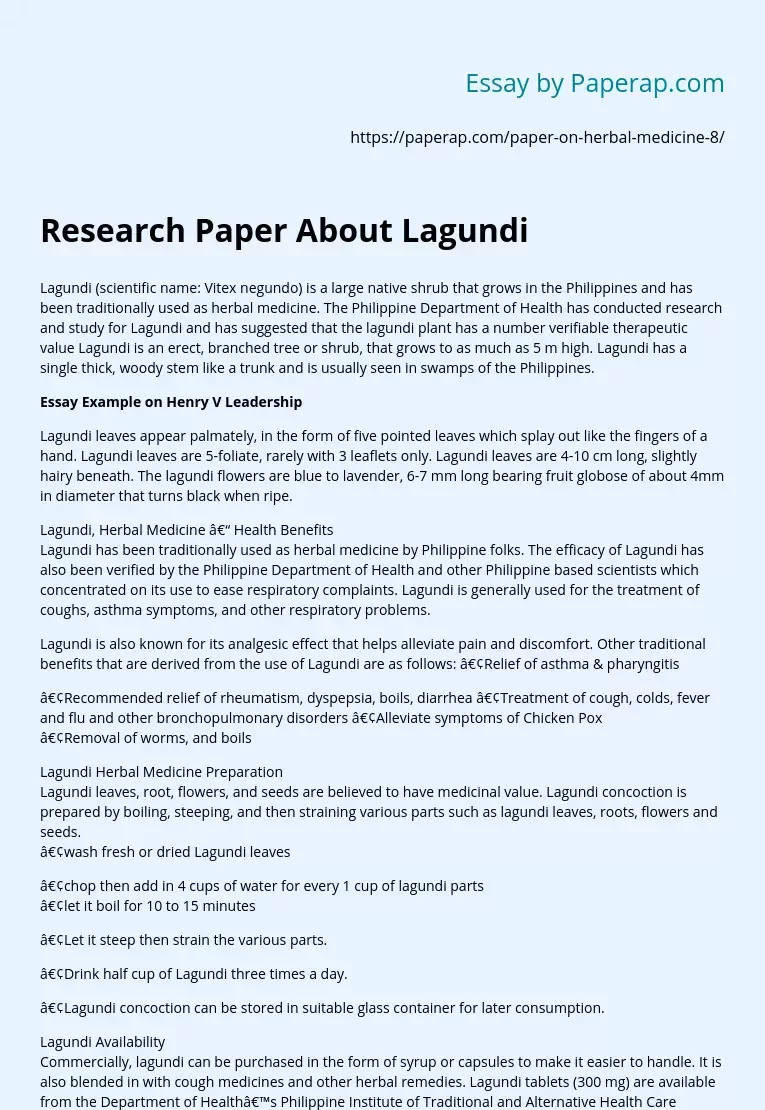Research Paper About Lagundi
Lagundi (scientific name: Vitex negundo) is a large native shrub that grows in the Philippines and has been traditionally used as herbal medicine. The Philippine Department of Health has conducted research and study for Lagundi and has suggested that the lagundi plant has a number verifiable therapeutic value Lagundi is an erect, branched tree or shrub, that grows to as much as 5 m high. Lagundi has a single thick, woody stem like a trunk and is usually seen in swamps of the Philippines.
Essay Example on Henry V Leadership
Lagundi leaves appear palmately, in the form of five pointed leaves which splay out like the fingers of a hand. Lagundi leaves are 5-foliate, rarely with 3 leaflets only. Lagundi leaves are 4-10 cm long, slightly hairy beneath. The lagundi flowers are blue to lavender, 6-7 mm long bearing fruit globose of about 4mm in diameter that turns black when ripe.
Lagundi, Herbal Medicine – Health Benefits
Lagundi has been traditionally used as herbal medicine by Philippine folks.
The efficacy of Lagundi has also been verified by the Philippine Department of Health and other Philippine based scientists which concentrated on its use to ease respiratory complaints. Lagundi is generally used for the treatment of coughs, asthma symptoms, and other respiratory problems.
Lagundi is also known for its analgesic effect that helps alleviate pain and discomfort. Other traditional benefits that are derived from the use of Lagundi are as follows: •Relief of asthma & pharyngitis
•Recommended relief of rheumatism, dyspepsia, boils, diarrhea •Treatment of cough, colds, fever and flu and other bronchopulmonary disorders •Alleviate symptoms of Chicken Pox
•Removal of worms, and boils
Lagundi Herbal Medicine Preparation
Lagundi leaves, root, flowers, and seeds are believed to have medicinal value.
Lagundi concoction is prepared by boiling, steeping, and then straining various parts such as lagundi leaves, roots, flowers and seeds.
•wash fresh or dried Lagundi leaves
•chop then add in 4 cups of water for every 1 cup of lagundi parts
•let it boil for 10 to 15 minutes
•Let it steep then strain the various parts.
•Drink half cup of Lagundi three times a day.
•Lagundi concoction can be stored in suitable glass container for later consumption.
Lagundi Availability
Commercially, lagundi can be purchased in the form of syrup or capsules to make it easier to handle. It is also blended in with cough medicines and other herbal remedies. Lagundi tablets (300 mg) are available from the Department of Health’s Philippine Institute of Traditional and Alternative Health Care (PITAHC) Telephone # (632) 727-6199. Lagundi syrup is now commonly formulated as cough medicine which can also be bought in leading drugstores and supermarkets.
Warning and Side Effects of Lagundi
Lagundi use is widely acceptable as safe for use for children and adults and no adverse reaction has been reported. However, moderate use is recommended for pregnant women, and treatment should not exceed one week. If symptoms persist and irritation occurs, stop the use and consult your doctor.
Research Paper About Lagundi. (2019, Nov 27). Retrieved from https://paperap.com/paper-on-herbal-medicine-8/

